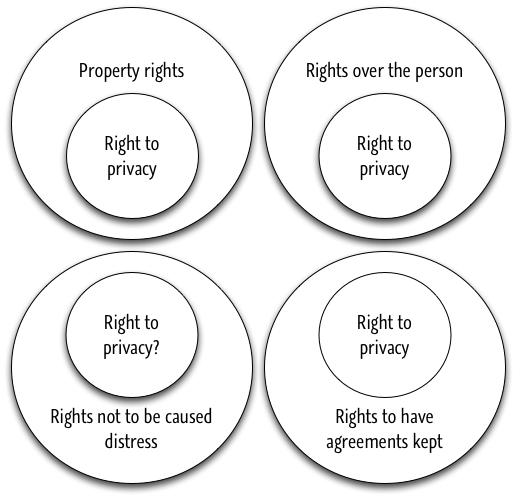Main points
- Thomson’s simplifying hypothesis.
- What you think about Thomson’s right not to be looked at.
The main idea in Thomson’s article is what she calls the “simplifying hypothesis” that the right of privacy is not a distinct right on its own but is rather protected by other rights.
Here’s an illustration of the simplifying hypothesis: privacy shows up as a subset of other rights. The hypothesis is that it only shows up within other rights and never on its own.

You might ask, “so what do all the little privacy circles have in common, such that it makes sense to use the same word for them?” I think Thomson would say that there is no illuminating answer to that question. The simplifying hypothesis simplifies the right to privacy by giving up on the attempt to identify a distinct, unified right to privacy. Since everything we’re inclined to call part of the right to privacy is already protected by some other right, there is no need to bang our heads against the wall of saying what, exactly, the right to privacy involves and why it is valuable.
If she is correct, then considerations about privacy don’t really explain why we have any of the rights that we do. You have the right to privacy because you have property rights, rights over your person, and so on. You don’t have those other rights because you have the right to privacy (Thomson 1975, 312–13).
Even though she despairs of a unified theory of privacy rights, Thomson does think there are some useful generalizations. For instance, some of the rights that make up what we loosely call the right to privacy are rights that limit how others can acquire private information (Thomson 1975, 307–8) while others are rights governing how others can use information (Thomson 1975, 310–12). I find that distinction useful.
For an example of how the right to privacy governs the acquisition of information, consider property rights. My property right to my watch means that you have a duty not to take the watch without my permission. Thomson thinks it also means that you have a duty not to look at it without my permission. When I wear the watch in public, I am tacitly giving my permission for anyone to look at it. But when the watch is in my house I am not granting permission and so you violate my right to privacy if you look at it.
By the same token, she thinks there is a general right not to be looked at and that this right is waived by a person who is walking in the street but that it is not waived by a person who is inside her house. Consequently, if you take unusual steps to look at people in their houses, like using an x-ray machine, you violate their right to privacy.
Rights governing the use of information are trickier. Thomson says that if there is such a right, it has to be derived from the right not to be caused distress. But this seems to be a merely hypothetical point for her. She thinks the right not to be caused distress is outweighed by the freedom of the press, so there is really no privacy right against publication of information in the press (Thomson 1975, 310). And she does not think that there is a right that private individuals not gossip about you, no matter how hurtful their doing so may be (Thomson 1975, 311–12).
So there is space in Thomson’s analysis for the cases that Warren and Brandeis thought were central, namely, rights to control the publication of personal information. But it is merely logical space for her.
One thing that came up in our discussion was whether Thomson is talking about moral rights to privacy or legal rights. I said that she was talking about moral rights. I stand by that! But it occurred to me that she is not completely consistent. Consider this argument.
My objection is, rather, that even if there is a right to not be caused distress by the publication of personal information, it is mostly, if not always, overridden by what seems to me a more stringent right, namely the public’s right to a press which prints any and all information, personal or impersonal, which it deems newsworthy; and thus that in the case I mentioned no right is violated, and hence, a fortiori, the right to privacy is not violated. (Thomson 1975, 310)
This is clearly about a legal right to privacy and not a moral one. If you spread my private information by gossiping about me, I might be in a position to say, correctly, that you have violated my moral right to privacy. “That was private! You were not allowed to tell everyone that!,” I might say. Obviously the public utility of a free press has nothing to do with this sort of personal case. It is, however, relevant to a legal right to privacy that an individual could use to ask the courts to prevent a newspaper from publishing private information.
In other words, what we have here is a reference to legal rights to privacy rather than moral ones.